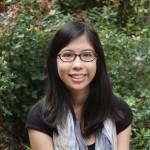
Erica Lin
Brown University
Freshman, Applied Mathematics – Biology and East Asian Studies
Expected Graduation: May 2019
Host Lab in Japan: Awazu Lab, Osaka University
Research Project Abstract and Poster: Evaluation of Porphyrus Envelope as a Novel Drug Delivery System for Photodynamic Therapy of Prostate Cancer ![]()
Why Nakatani RIES?
Exposure and participation in an international research experience is extremely important for science & engineering students in the United States as research has become increasingly multinational. What drew me to Nakatani RIES is the opportunity to fully experience the diversity of Japanese research and its tenets as well as to grow as a research scientist. This program would allow me to extend upon my previous research experience, which involved working with Japanese researchers while in the U.S. Additionally, it would serve as the ideal method through which to further pursue my interests in biotechnology, which I have explored as an Applied-Mathematics concentrator. Nakatani RIES would give me both the knowledge and skills that would allow me to conduct work that is interdisciplinary—a factor I believe to be essential in light of the increasingly complex problems the research community is solving.
Through programs such as this one, students are not only able to experience a different technical viewpoint on the subject material, but also develop an understanding of the cultural backgrounds of the researchers they are working with—a crucial component in successful partnerships. By exposing students in the U.S. to international research early in the careers, Nakatani RIES gives them the opportunity to develop the communication skills necessary to conduct projects across national lines that are able to address issues ranging from societal differences to time-zone variation for time-sensitive experiments. I am looking forward to delving deeper into the world of biotechnology, connecting with a wide variety of people who each bring a different set of experiences to the table, and explore how my heritage will play a part in my future career.
Goals for the Summer
- Understand my project well enough so that I can explain it to a wide variety of audiences (e.g. from younger students to scientists in the same field)
- Connect with lab members at both professional and personal levels, as well as make friends in my host university and surrounding community
- Keep an open mind and learn something new about myself
- Take advantage of as many opportunities as possible to explore my Japanese heritage (e.g. visit to museums and historical locations)
Research Internship Overview
People in Osaka are known to be friendly as well as easy-going and I found that notion true for my laboratory. I was quite nervous when first meeting them, but they welcomed me with open arms. The laboratory was split into several research focus groups (for example, I was in the photodynamic therapy group), with the unifying tie between all the work being that they involved the use of lasers in some way or another. I thought that such groupings would make it hard for me to get to know members of the laboratory who were in a different group than me, but I thankfully didn’t find it a problem at all. Nevertheless, I did spend more time overall with people in the photodynamic therapy group as I was sharing much of the same space/equipment. I had two mentors this summer from the photodynamic therapy group who provided amazing support and were genuinely interested in the success of my project. I am very thankful for them as they were always checking in and making sure that the project was running smoothly and offering their help.
Like other Japanese laboratories, the Awazu laboratory worked very hard and for long hours, usually till late at night and occasionally past midnight/overnight or weekends. Every lab member had to submit weekly, monthly, and yearly reports on their work so that the senseis always knew of their work’s progression. Posters lined every free space in the experiment room with the work that members presented at recent conferences. Nevertheless, it was a very social environment and they would take the time to engage with other lab members, whether it be for a lunch at a campus eatery or out for a night at an izakaya. I really appreciated that they always invited me as well, and I got to have a lot of memorable experiences such as going out to bowling as well as a yakiniku (Japanese BBQ) restaurant. The only times I would eat lunch alone was when I was running an experiment that ran through lunch hours; otherwise, I would always be eating with at least one labmate. They also quickly caught onto my passion for traveling and brought me to various parts of the Kansai region, including Kyoto, Nara, and Kobe. It was wonderful to have the opportunity to explore these areas with people who are familiar with the area and showed me places I would have never discovered on my own. I also had the opportunity to view Tenjin Matsuri, a summer festival that takes place in Osaka every year, with one of my mentors. The openness of all the members of the Awazu laboratory led to many memories I will always cherish.
My research project investigated porphyrus envelope as a novel drug delivery system for use in prostate cancer treatment. Porphyrus envelope is a drug delivery system being developed by the Awazu laboratory and is created by incorporating light sensitive drugs into the inactivated form of the hemaggluttinating virus of Japan. It has been specifically developed for use in photodynamic therapy, a method of treatment which relies on the cancer-selective accumulation of light-sensitive drugs. Upon light stimulation, these drugs lead to cancer cell death. The project focused on evaluating the effectiveness of porphyrus envelope through accumulation assays as well as investigations of its cytotoxicity.
This work related to my current academic interest in immunology and biostatistics as well as my future career goal of becoming a physician researcher. I loved having the chance to explore my passion for biomedical research, which was made even more exciting by the fact that I may be in the future using this drug delivery system in the clinic. Working in an international research setting was a unique experience and the experience has definitely honed me into a researcher that can better navigate large collaborations and multinational projects. The location of this experience in Japan is what it particularly amazing—I was able to dive into the community whose work I had read in scientific journals and that I heard about from the visiting researchers I worked with at a previous research internship in the U.S.. Nakatani RIES has also made me strongly interested in returning to Japan in future summers to conduct more research.
Daily Life in Japan
On weekdays, I would go to the laboratory via university shuttle, arriving at around 9:30 a.m.. At the laboratory, my day was filled with a mix of experiments, lab meetings, report writing, and Japanese science lectures. I would stay there until the last shuttle to my dormitory left at 8:15 p.m. As there were very few places to eat around my dormitory and the dining hall on that campus would close at 6:30 p.m., I often ate with my labmates before heading back. Though we occasionally tried to change it up, our go-to place was Don Don, which was located only 3 minutes away and served a variety of dons (rice bowls) and udon. It was a general consensus that the best dish there was the tenshin mapodon, an Osaka University specialty composed of a thick meat and tofu stew poured over a bed of rice. As the Kansai region had plentiful sightseeing options, I made sure to make the most of my weekends there as well. I would be out exploring as much as I could, often joined by other Nakatani RIES fellows University or labmates—through some planning, I was able to check off everything on my bucket list and, to satisfy the inner temple and shrine enthusiast in me, visit 61 of them!
Complete the following sentences with the intended audience for these responses being potential applicants to the Nakatani RIES Fellowship.
- My favorite experience in Japan was… exploring the Kansai region with my labmates and the other Nakatani RIES fellows.
- Before I left for Japan I wish I had… a better grasp of kanji I might encounter in my day-to-day life.
- While I was in Japan I wish I had… practiced more Japanese with my labmates.
Excerpts from Erica’s Weekly Reports
- Week 01: Arrival in Japan
- Week 02: Trip to Akita
- Week 03: Noticing Similarities, Noticing Differences
- Week 04: First Week at Research Lab
- Week 05: Critical Incident Analysis – Life in Japan
- Week 06: Preparation for Mid-Program Meeting
- Week 07: Overview of Mid-Program Meeting & Research Host Lab Visit
- Week 08: Research in Japan vs. Research in the U.S.
- Week 09: Reflections on Japanese Language Learning
- Week 10: Interview with a Japanese Researcher
- Week 11: Critical Incident Analysis – In the Lab
- Week 12: Final Week at Research Lab
- Week 13: Final Report
- Tips for Future Participants
Week 01: Arrival in Japan
The moment I stepped off of the plane at Narita Airport, the sensory overload had already begun. The script greeting us scrawled across the walls, a language I could not understand resonating out of the speakers overhead, combined to form a wave of sensations I tried to sort out. Even though I had just arrived, I was already beginning to see the cultural differences around me. I was amazed as people formed into queues without instruction from the immigration officer in a uniformness that would have been impossible in the airport of my hometown New York City. This next week was going to be a whirlwind of experiences thrown at to me in quick succession without much warning, but I was ready to try to absorb as much of each one before it got blown away and replaced by another.
The first hurdle blown into my path appeared the next morning at the start of the Japanese language classes. My knowledge of Japanese consisted of the few phrases thrown around in my grandparents’ household, and though I could sound out the words written in katakana/hiragana, I was frequently left with a bundle of sounds and no idea what they meant. Due to this background, I was a bit anxious when my first class started. As the class progressed, however, my sensei and I realized that I had to make a decision – whether I would remain in this beginner class or step up to a higher level language level class starting the next day. At first, I was hesitant. I knew my skills were not on par with the other students already in that section, but this was an opportunity for me to challenge myself and learn much more of the language. I tentatively switched into the higher level class the following day, and I am very glad I did. The small class size (4 students) has kept me on my toes at all points and allows for more individual attention from the senseis (“sensei” = “teacher” in Japanese). The senseis have been very kind but firm in their teaching, and their passion for showing us the beauty of the Japanese language has inspired me to study even harder. Every night, I read over my notes from the Japanese classes to absorb more of the grammar and vocabulary and continue to practice my hiragana/katakana using worksheets so that I am able to read them faster. While the Japanese lessons have been similar to what I expected — a challenge– it is a welcome one. It is extremely satisfying to be able to use the Japanese I had just learned in class in my daily life in Japan; for example, after the second day of classes, I was able to order lunch and explain that I was eating inside of the restaurant using the vocabulary I had learned earlier that morning.
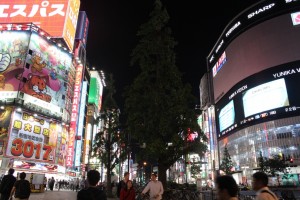
The rest of the week was full of little puzzles I had to figure out as I navigated a culture very different from that of the United States, with many of them leading to delightful discoveries and memories I will always treasure. One instance occurred during our second day in Tokyo, when I went out to Shinjuku with a few other Nakatani RIES fellows. No one in the group had above a basic working knowledge of Japanese, but with the trusty Tokyo Subway Navigation app, we were able to reach the area. As we wandered Shinjuku, ducking into some of the stores lining its streets and admiring how busy the area was, I was in a constant state of amazement. Even after growing up in New York City, I was surprised by the pure energy of this area; its bright neon signs and flashing billboards were even more impressive than that of Times Square. What stood out to me the most, however, was the kindness and attentiveness of the Japanese people. On my way to Yodobashi Camera, a large electronics chain with a main store in Shinjuku, to get a SIM card for my American phone, I got a little bit lost. I knew I was close by, but I couldn’t pull up Google Maps like I would back home to get directions to the store. I decided to use the little Japanese I had to ask a Japanese storekeeper how to get there, and was shocked that not only did he give me directions, but when he noticed my slightly puzzled face (I understand the word for “right” but not much else), he also led me all the way to the store. After profuse bowing and “domo arigatogozaimashita”s, I reflected on what had happened before stepping into the store. This experience showed me the Japanese people’s politeness and willingness to help was even higher than what I had imagined; such an occurrence would never have happened or be very rare in the United States, especially in my hometown of New York City. The level of attention that Japanese people pay to others was particularly surprising to me. This experience left me wondering what led to the development of such a community-oriented mindset in Japan as opposed to a more individualistic one in the United States.
The various cultural activities also provided windows into Japanese culture. Packard-san’s lecture on Japanese culture proved invaluable as I made my way around the city. The information, which spanned from common Japanese formalities to what to do in during an earthquake, came in handy when a 5.0 earthquake struck during our second day, and I’m sure will continue to be useful over the coming weeks. The evening discussion session on American politics with members of the KIP organization, an organization run by Packard-san which consists of students from universities around the Tokyo region, gave me an insight of how foreigners are viewing America’s state of affairs. I thought it was particularly interesting how much they knew about Trump’s policies in particular. The discussion on Trans-Pacific Partnership (TPP) was also very intriguing as I had not heard much about this policy in the United States even though the U.S. is an active player in this policy. TPP would open up the trade restrictions between the United States and Japan, which would be particularly beneficial for the Japanese auto industry and the American agriculture industry. It was interesting to note the various opinions in the room, especially since in a recent poll run in Japan, ~40% of people supported this policy, 40% were against it, and 20% had no opinion. This discussion also gave me the opportunity to meet Japanese college students and talk about their collegiate life in Japan as well as their hobbies/past-times, one of activities I had mentioned during pre-orientation at Rice that I was looking forward to doing when in Japan.
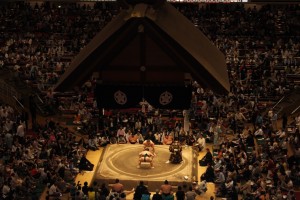
The activity which I believe best encapsulates my experience in Japan so far was the sumo tournament the Nakatani RIES fellows attended on Thursday (May 19th). I had occasionally watched sumo videos with my grandmother while growing up, but the younger version of myself would quickly grow disinterested as it seemed like there was so little “action”. When I went to the sumo tournament, however, I realized just how limited my earlier view of sumo was. When we entered the main hall, I was amazed at the quantity of people who had come to watch the tournament; it was at least the size of a football stadium if not larger. The tension in the hall during matches was almost tangible, and I was quickly absorbed into the intricacies of sumo. Though the “action” itself would not last more than a few seconds, each match would last around 5-10 minutes from start to finish due to the rituals before each one. The knowledge I now had on the Shinto origins of sumo added another layer to the experience. I was fascinated as I watched the sumo wrestler ready themselves and get into position, only to stand back up again and slap the back of the legs as intimidation and to diminish the morale of their opponent. The buildup to the start of each bout was just as exciting as the fight itself. After returning to Sanuki Club that night, I researched the various aspects of sumo I thought were interesting but could not understand their meaning. This experience showed me the shallowness of my knowledge of Japan, and while I might learn more about while experiencing it, there is so much more to discover.
This first week was a rush of experiences and has made me excited to explore and learn more about Japan in the coming months.
Introduction to Science & Engineering Seminar
Kono-sensei’s Introduction to Science & Engineering lecture covered several topics in the material sciences and physics, ranging from metals/insulators to quantum mechanics. It was particularly intriguing as it gave me insight into the research Nakatani RIES fellows will be conducting over the next summer. Though I still have a few lingering questions regarding lasers after the lecture, it provided me with a greater physics background with which to approach my project as I had previously been viewing it from a biology standpoint.
Though I was very fond of the cultural explorations, the laboratory tours at the University of Tokyo was my favorite part of the week. I was stoked to see research I had read about in science journals in real life. While at the University of Tokyo, I had the opportunity to visit three laboratories with the program: the Mitsuishi/Sugita Laboratory, the Yamamoto Laboratory and the Murayama Laboratory. The Mitsuishi/Sugita laboratory worked on medical robots to be used in surgeries of the eye, the brain, and the liver. The group created systems that allowed the surgeon to conduct the surgeries remotely through a combination of the robot, as well as an eyepiece which allows the surgeon to view the surgery in 3-D. The Murayama laboratory conducted research on ship dynamics and had a simulator within the laboratory to test the effects of wave force as well as the effectiveness of their models. The Yamamoto laboratory pursued mechatronics research. Their projects included a haptic feedback system to simulate the feeling of playing air hockey and squishing a foam piece, with applications in the gaming industry, as well as a robot that moves solely using the heat energy of the surface it is on.
The research I found most fascinating was that of the Mitsuishi/Sugita laboratory due to my own career goal in becoming a physician scientist. It was interesting to see the type of technology I may be using in the clinic in the coming years. The get-together with graduate students from these laboratories after the tours played a large role in making this experience my favorite part of the week. The graduate students provided insightful information on what it is like to work pursue a degree in a Japanese university, and how the experience changes as an international graduate student.
Initial Research Project Overview
Photodynamic therapy is the use of photosensitizers (PSs), nontoxic dyes/drugs, with harmless light in the presence of oxygen to cause the creation of cytotoxic materials which leads to cell or tissue death. It has several uses in the biology and medicine fields as it is a minimally invasive procedure. While originally used in the treatment of cancer tumors, its use has spread to other nonmalignant diseases as well.
The effects of photodynamic therapy are influenced by the oxygen supply, photosensitizer amount, and fluence rate of light in the system, with the latter affected by optical properties of the tissue (ie. refractive index, scattering coefficient, etc.) Traditional photodynamic therapy consists of a monochromatic emission, but there has been increasing attention on photodynamic therapy using light emitting diodes (LEDs) as opposed to conventional lasers as LEDs are of lower cost. The main issue with LEDs, however, is that their broad spectral bandwidth emission is very different from that of a laser; therefore, parameters for LED use in photodynamic therapy have to be investigated as they are not the same as that of the traditional lasers. These parameters include irradiation power, irradiation time, as well as wavelength.
The Awazu Laboratory has recently been investigating a novel tumor model to assess these parameters. The conventional method, the mouse tumor model, has been put under increasing scrutiny due to ethical concerns/regulations. The Awazu group investigated an alternative—the CAM tumor. The CAM tumor, a 3D system, is a tumor model created using tumor cells grown on the chorioallantoic membrane (CAM) of chicken eggs. This tumor is frequently utilized in studies on angiogenesis (formation of new vessels), with its popularity stemming from the fact that this model is more simple and affordable than mammalian ones. Previous research on the CAM tumor model in photodynamic therapy included studies on the the effect of anti-angiogenic drugs in the photodynamic system as well as the use of the hexenyl ester of the 5-aminolevulinic acid in photodynamic therapy using the CAM tumor model. However, to increase the effectiveness of photodynamic therapies utilizing the CAM models, light dosimetry needs to be established. The Awazu laboratory has approached this problem by investigating the optical properties of the tissue. An optimized tumor model would allow for increased experimentation on the optimal light/drug dosage in photodynamic therapy, thus leading to better patient treatment.
Research Paper Summary
I reviewed “Optical properties of tumor tissues grown on the chorioallantoic membrane of chicken eggs: tumor model to assay of tumor response to photodynamic therapy“.
This paper studied whether the CAM tumor model can be used as a viable alternative to the conventional mouse tumor in photodynamic therapy research through the investigation of the tissue’s optical properties. The study focused on optical properties in the near-infrared and visible wavelength ranges because the photosensitizers used in photodynamic therapy have absorption bands in these ranges. The samples used in this study consisted of tumors implanted into the backs of mice and CAM. The optical properties of the tumor models in the 350-1000 nm wavelength ranges was measured using a double integrating sphere optical system with an intervening sample and an inverse Monte Carlo method. The inverse Monte Carlo method calculated optical properties from the reflectance and total transmittance values obtained through the double integrating sphere optical system. Histological stains were also conducted to further compare the two systems. The effectiveness of the CAM tumor system was investigated through tissue extraction and high-performance liquid chromatography of the photosensitizer protoporphyrin IX.
Results from the Monte Carlo analysis indicated negligible differences between the two tumor models in terms of the optical properties and a slight sensitivity to anisotropy factors and refractive indexes. The CAM tumor tissue had a shorter optical penetration depth than the mouse tumor in the 451 to 512 nm range, with the correlation coefficient of 0.99 between the two tissues and standard deviations similar to each other. These similar standard deviations indicate optical variability within CAM tumor groups and mouse tumor groups are similar. Histological analysis showed that the mouse tumor tissue was significantly denser than the CAM tumor tissue. This difference may impact the efficiency of photodynamic therapy as the accumulation of photosensitizers depends on the cell density. The two tissue models also had similar major axis and morphology (irregular, intertwining spindle-shaped tumor cells). Analysis of the high-performance liquid chromatography indicated that the CAM tumors accumulated the photosensitizer in a similar fashion to the mice tumors. The paper overall showed that CAM tumor tissues and mouse tumor tissues had similar optical properties and stabilities. It demonstrated that the CAM tumor model can serve as a cheaper and more ethical alternative to the mouse model, thus providing new paths for future research on optimal irradiation conditions in photodynamic therapy for use in patient treatments.
Week 02: Trip to Akita
Akita was a breath of fresh air—both metaphorically and physically. Tokyo’s bounty of flashing lights and sounds was replaced by constellations clear against the background of Akita’s black night sky and a medley of rustling leaves. The weekend trip to Akita allowed for us to explore Japan’s nature side and delve into its deep cultural history.
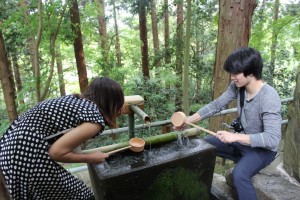
In order to reach the Iwate region, we took a shinkansen (bullet train). It was a very exciting experience—once the shinkansen hit the city borders, its speed dramatically increased and it felt like the train was gliding across the countryside. The large cities we passed by, such as Sendai, and expanses of rice fields were interesting contrasts to each other. Upon our arrival in the Iwate region, we went to the Motsuji Temple, which was part of the Tendai sect of Buddhism. Unfortunately, repeated fires destroyed many of its buildings, but its famous land garden remained. This garden, one of the few remaining pure land gardens in Japan, is notable for its rock arrangements. We then visited Chusonji Temple, which is also part of the Tendai sect. Before entering the temple, we had to cleanse ourselves using the dippers in the stone basin outside the temple, first washing our hands, then by our mouths. The temple’s most striking feature was Konjikido, a hall covered completely in gold. The dim lights inside the protective building around this hall was completely necessary; if this hall had been open to sunlight, the sun’s reflection off of the gold would have made it extremely difficult to make out the intricate details of the statues inside the hall and of the hall itself.
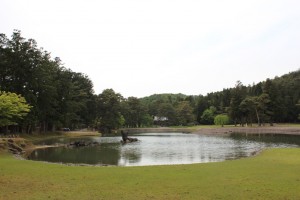
Upon finishing our exploration of Chusonji Temple, we headed to the ryokan we were staying for the next two days. We were in for a treat—mochi-tsuki. Mochi-tsuki, or pounding mochi, is a traditional event in which boiled rice is turned into mochi through repeated pummeling of the rice mass punctuated by molding it and adding water. We were lucky to have the opportunity to participate in the mochi-tsuki and it was amusing to see the other Nakatani RIES fellows’ pounding styles and compare it to the smooth ease the head mochi pounder handled the kine, a wooden mallet. We were then able to test our hand at local rope making, with some of us skilled enough to make rope crowns and others left with some very interesting configurations. During dinner, we were able to try many Akita prefecture specialties, such as kiritanpo, toasted rice cylinders, in nabe, hot pot, as well as vegetables picked from mountains nearby. The meal was capped off with the mochi we had just made rolled in peanut powder or sesame paste. It was oishii (delicious)! We were able to experience yet another Japanese tradition before laying down to sleep on the tatami mats—onsen, Japanese hot spring baths. Following tips from the KIP students who had come with us to Akita, we relaxed in the baths, letting our muscles slowly unwind.

The following day, we explored more of the area as well as had the opportunity to meet with locals and talk about the region. The first stop was Lake Tazawa, a caldera lake which has not experienced much development and has thus retained its rustic charm. I biked around the lake with Mayssa, Shweta, Nickolas, and Risa (a KIP student); the vibrant green leaves overhead, the breeze ruffling our hair as we pedaled, and the scenic lake, all combined to make this ride very soothing. After picking up students from Akita International University, we visited Omagari Agricultural High School. The first thought that came to my head was the cleanliness of the high school. The sunlight streaming through its large windows did not reveal any dust or dirt whatsoever. While at the high school, we had the opportunity to hear about the local agriculture industry from a local farmer. This farmer, a graduate of Omagari, highlighted the difficulties farmers in this area are facing as the price of rice—their main crop—has declined drastically the past few years. He described efforts to diversify the crops being grown to meet an evolving consumer demand as well as efforts to bring more young people into an industry in which 40-year-olds are still considered “young”. This lecture had a great impact on me due to my interest in how modern society has affected traditional practices/professions. While I had some background knowledge on how this issue plays out in the United States, this lecture gave me the Japanese perspective.
Following this lecture, we listened to a presentation by Omagari students on their science project, a cost-effective and efficient way to combat the acidification of Lake Tazawa. We then discussed in small groups a proposal suggesting the integration of agricultural education into the Japanese curriculum. The variety of opinions on this topic was very interesting. There were a few students from the agriculture high school that didn’t support the proposal, which I found quite surprising given their chosen topic of study. A challenge I encountered during this discussion was the high language barrier between the high school students and I; I had gotten used to the KIP and Akita International University students, who spoke highly proficient English. Nevertheless, through consultations with the KIP and Akita International University students in the group, we were able to have a decent conversation.
The next morning, we discussed the economic revitalization in Akita, with a focus on bringing sightseeing and young people to the region since the area had a rapidly aging population. I was a bit shocked by the pessimism of the local Akita International University students regarding bringing increased tourism. Many thought Akita has nothing particularly “special”—while it does have beautiful hiking trails, scenery, and historical places, they believed that there are other places in Japan that are “better”. That afternoon, we visited Kakunodate, a town known for its samurai history. We had the opportunity to visit the oldest intact samurai house, the Ishiguro House. The tour of this house was led by a descendent a samurai, and the tone of his voice as he explained the house’s history and its different parts reflected the reverence Japanese hold for their ancestors and for Japan’s deep history. This weekend provided a window into Japan’s past. While I personally identify more with cities, it sparked an interest in Japan’s rural areas.
The cultural excursions during the remainder of the week were opportunities to explore Japan’s rich cultural heritage. Our visit to the National Museum of Nature and Science gave a viewpoint on important flora and fauna in Japan, as well as pre-Meiji period science. The next door Tokyo National Museum was a treasure trove of Japanese and Asian art; it was exciting to me to see the development of Japanese art—and through the art Japan’s culture—from the Jomon period (14,500-300 BC) to more recent periods. The taiko drumming outing provided a glimpse into traditional Japanese music. These excursions made me wonder to what extent the arts are taught in the Japanese schooling system.
It was also interesting to compare this week’s evening discussion session with that of the week before. The topic of discussion was artificial intelligence, and if there was anything impossible for artificial intelligence. Unlike last week’s session, there were fewer differences in opinion among the Nakatani RIES fellows and the KIP students who joined us for the session. The language classes also intensified this week as we learned a multitude of verbs and many conjugations and sentence structures. It has been a very rewarding experience to be able to use the Japanese I have learned in class; I have noticed that I feel more comfortable asking questions in Japanese, and can understand more of others’ answers. I am looking forward to the development of my Japanese language skills over our last week in Tokyo and to use them as I explore the city.
Introduction to Science & Engineering Seminar Overview
Professor Christopher Stanton’s Introduction to Science & Engineering lectures covered several topics in physics, ranging from quantum mechanics to modern physics. In his first lecture, he discussed topics such as k-spaces, the effective mass theory, quantum wells, nanotransistors, band gap engineering, and LEDs/lasers. The second one covered carrier dynamics, THz radiation, and three types of coherent phonons. He described black bodies, an idealized collection of matter that is able to absorb all incident electromagnetic radiation. When the black body is at a constant temperature, it emits black-body radiation, a form of electromagnetic radiation. The radiation has a frequency spectrum linked to the black body’s temperature; the spectrum is also known as the Planck spectrum. The spectrum peaks at a characteristic frequency which increases with higher temperatures. At room temperature, the emission lies in the infrared region; as the temperature rises, visible light begins to be emitted by the black body. The black body glows a dull red at lower temperatures, and as the temperature increases, reaches a blue-tinged white. At that point, it also emits ultraviolet radiation.
Professor Stanton also discussed optical properties. The Awazu group has previously investigated several optical properties of the chorioallantoic membrane; these properties included absorption coefficient, scattering coefficient, anisotropy factor, and refractive index. The material was probed using a double-integrating sphere system with an intervening sample, an interesting tool since it measures total transmittance and diffuse reflectance at the same time. These properties in this specific material are not changed by quantum confinement effects. Professor Stanton’s lectures allowed for me to gain a better understanding of the physics behind the project I will be working on this summer. I am interested in learning more about the physics concepts behind the medical procedures being conducted today.
There were also two guest lectures this week by Otsuji-sensei from Tohoku University and Ishioka-sensei from National Institute for Materials Science. Otsuji-sensei described his research on terahertz, a field which involves sub-millimeter coherent electromagnetic waves which has the potential to revolutionize communications and information technologies. His engaging lecture—complete with pachinko ball analogies—described his research on ultra-broadband integrated signal-processing systems and devices in the terahertz frequency. Ishioka-sensei presented her work on phonons, collective nuclear oscillations in crystals. She described how electrons and phonons are intertwined with each other and how ultrafast (femtosecond-nanosecond) spectroscopy could probe the behavior of electrons and phonons in their characteristic time scales. These two lectures provided an interesting viewpoint into the cutting-edge research being conducted in the fields Professor Stanton and Kono-sensei covered in their lectures. Professor Ishioka’s presentation on what it is like to be a female scientist in Japan was also particular intriguing; it was interesting to compare the efforts undertaken to stimulate increased female participation in the sciences in Japan to those in the United States.
Week 03: Noticing Similarities, Noticing Differences
Though the Tokyo Subway, Japan Railroad, bus lines, and pedestrian passageways zigzag their way across the entire city, the flow of passengers through rapidly departing trains and busy crossings is never interrupted. Many Japanese place a priority on efficiency and ensuring the well being of the overall community, and nowhere is it more apparent than in their transportation system. While similar in some aspects to that of my home city of New York, the Tokyo transportation system has several differences that make riding on it a distinct experience.
Traveling on Tokyo public transportation is a mostly silent journey. The only noises heard are usually the automatic announcements or the whirring of the vehicle’s machinery. Japanese tend to be very quiet; even when traveling with others, they keep their conversations to a whisper or check their smartphones (though never for a call). Such an environment makes it easy for others to sleep on the trains; it is very common to see multiple sleeping people in the early mornings or late afternoon/night. Considering the heavy work-ethic in Japanese culture, such naps are probably essential for many of them.
When traveling in a group with other Nakatani RIES fellows, it is very apparent that we stand out due to our volume alone. Partially because of our excitement about Japan, but mostly because we are not used to staying quiet on public transportation due to no such norm in the United States, our chattering and laughter quickly fills up the train car/bus. After several stares during our journeys around Tokyo, I have found myself trying to use a softer tone when on the public transportation. Nevertheless, when looking back at each of these experiences, I also notice that I get unconsciously louder when I am trying to be heard over fellows’ conversations. When I travel alone, it is much easier to blend in—I frequently just stand near a pole and silently catch up on my journaling (I would regularly people-watch on public transportation in New York, but doing so can make Japanese uncomfortable). The only time I have seen Japanese break such social norms is when alcohol is involved. Alcohol is generally seen as a way for Japanese people to “loosen up” and express themselves in ways that would have been inappropriate in a work/office setting. It is very common for office mates to go out to izakayas (Japanese pubs) or bars after work. As compared to in New York, where being obviously drunk leads to several stares and possible admonishments/removal from train personnel, in Japan it is a much more accepted part of society.
The way Japanese take up space on public transportation is also very different from my experiences in New York. Though in NYC I can see an example in almost every subway car, I have yet to see a case of “manspreading” on a Japanese subway/train. The only time I have seen people take up more than one seat is when they fall asleep; even then, if they’re traveling with someone else, their companion will likely pull on their arm until they regain a more space-saving posture. These differences can be explained from both a practical and cultural standpoint. Taking up as little room as possible is a reflection of the Japanese ideal of maximum efficiency—using up less space means more people can get on the subway/train car and people can get to their destinations more quickly. At popular stations where many people get on or off, many Japanese start moving further into the car if they are not getting off at that station even before the train pulls into that stop. Such a move makes it so that the embarking/disembarking process can proceed more smoothly. This practice is very different from what usually occurs in NYC, where people usually just remain standing in their original places and people entering/leaving have to weave their way throughout the car. In terms of seating arrangements, I have noticed that Japanese are much more conscious about their choices. They are much more willing to move to ensure a group of passengers are able to stay together or so that an elderly/disabled person is able to sit. In “slow times”, such actions are not as necessary due to the availability of seats in the cars, but they are very apparent in rush hours (early mornings, around lunchtime, and in the early evening).
These differences can be explained using the core Japanese values discussed as part of the pre-departure orientation. Two of the core values I feel are reflected most heavily in the Japanese public transportation system are wa (harmony) and an emphasis on the group/community over the individual. In the United States, there is a much larger stress on individuality, sometimes at the cost of harming the community overall. Meanwhile, Japanese tend to consider whether their actions can possibly have a negative effect on others and actively seek to prevent any actions that do so. While there are advantages and drawbacks to each system, to me, the Japanese public transportation system has led to much more enjoyable and relaxing journeys.
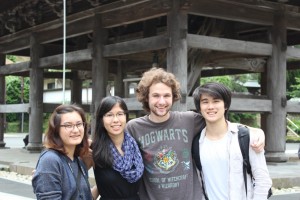
As this was our last week in Tokyo and its surrounding areas, I made sure to explore its multi-faceted cultural background as deeply as possible. Over the weekend, we had the opportunity to visit Kamakura with the KIP students. It was an amazing experience to step back in time and explore the temples and shrines with native Japanese people who could describe cultural significance that I may not have noticed. Standing beneath Daibutsu, the 2nd largest Buddha statue in Japan, was truly a humbling experience.
The last week of Introduction to Japanese Culture & Society seminars also gave me a viewpoint into different aspects of Japanese society I had not explored more of before. Professor Shimuzu-Guthrie’s lecture, which covered the history of baseball in Japan, provided a different perspective
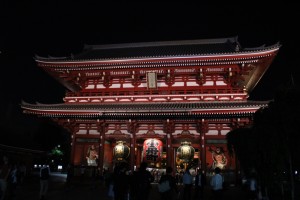
on Japanese society and one of the ways that the United States has influenced Japan’s sports scene. Dr. Lyon’s presentation, from the NSF Tokyo office, on science diplomacy showed me how to best use my experience in Japan this summer as a pivot into the field. Meanwhile, Packard-san’s lecture on Japan’s religions also provided additional context to the shrines/temples we have visited over the past few weeks, as well as the religious subtexts in sumo. This information came especially handy during my visit to Senso-ji temple the following day. The last discussion session with the KIP students was also an opportunity to discuss a topic I am very interested in—genetic testing—and find out some Japanese viewpoints on the subject matter. Nevertheless, my favorite cultural activity of the week was watching kabuki theater.
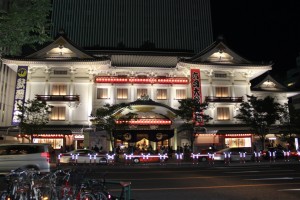
Watching a kabuki play was at the top of the list of activities I wanted to do in Japan, so I organized an outing for the Nakatani RIES students to watch the Kawatsura Hogen Yakata section of the Yoshitsune Senbon Zakura play (which was highly recommended by Endo-san). It was fascinating to see in person all of the little details that make the play so spectacular. However, upon observing the age range of people at the theater, I wonder if the younger generation will still keep such a vibrant practice alive as we were the youngest theater-goers by far.
As this was our last week in Tokyo, it meant that it was also our last week of language classes. The speeches at the end of the week really astounded me as they were a testament to how much we learned in such a short time. The goodbye to the language teachers was bittersweet; while I was sad that I would no longer be seeing them every weekday morning, I am excited to show them how much I will have learned after eight weeks in Osaka during the OPI at the end of the program. As I prepare to leave for Osaka, I am a bit nervous about meeting my labmates and professors, but mostly excited about the coming weeks in a new area of Japan.
Introduction to Science & Engineering Seminar Overview
Professor Bird’s Introduction to Science & Engineering lectures provided an overview of bandgap engineering and the use of graphene in nanoelectronics. In the first lecture of bandgap engineering, he covered topics from a more basic introduction to solid-state physics to the beginning of the more complicated subject material covered by Kono-sensei and Professor Stanton in the first two weeks of the Introduction to Science& Engineering lecture series. It may have been helpful to hear this lecture as the first one in the series as it covered a lot more of the fundamentals that could have made it easier to understand the other lectures. In the lecture on graphene in nanoelectronics, Professor Bird discussed graphene properties that could make it a possible replacement for silicon in nanoelectronics. Professor Bird discussed the possible drawbacks that can hinder of such nanoelectronics—primarily, that the lack of a pronounced bandgap in this material has hindered profess. Professor Aoki from Chiba University also presented on his research, which focuses on nano-carbon materials and quantum structures, and more specifically, their transport properties.
Week 04: First Week at Research Lab
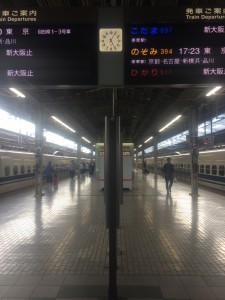
On the shinkansen ride to Osaka from Tokyo, I was equal parts excited and nervous about starting my time at the Awazu laboratory. I was looking forward to meeting my mentors and professors, but concerned about language barriers and differences in work culture. Though the first three weeks and the pre-orientation gave me an idea of what to expect, I was a bit jittery before meeting the laboratory for the first time.
However, had I known what the Awazu laboratory was like before arriving, I would not have been at all nervous. This past week at the laboratory has been an amazing experience; I feel like I have learned a lot in such a short time frame and everyone at the laboratory has been extremely friendly. They have really done the utmost to make me feel comfortable, from throwing me a takoyaki party when I arrived as my first welcoming party, to taking me out to bowling the following night, to inviting me out for dinner with the rest of my research subgroup at the end of the week. I have really appreciated these opportunities to get to know them better in more casual settings.
I have not run into many issues communicating with others in my laboratory, which I am very thankful for as it allows me to have deeper conversations that would be have been impossible with my surface-level Japanese. The laboratory has been hosting a German exchange student for the past ten months, so they are used to speaking in English. Nevertheless, though I have generally been able to converse freely with my labmates, whether it be over lunch or during breaks from work, I have not been able to interact a lot with the members in the laboratory that are not comfortable with their English. I will do my best to learn more Japanese over the next few weeks so that I can engage with them as well.
Unfortunately, the person I am having the most issues communicating with is my assigned mentor, Saito-san, a first-year master’s student. I have also not seen her much over the past week; she seems very busy and over in the laboratory building most of the time (the office space and work rooms are in separate buildings). On the other hand, I have been adopted by Inai-san, the sole doctoral student. She has been the one teaching me all of the protocols I will be using over the next several weeks; I have been really appreciated her kindness and patience as I learn the procedures as it has been two years since I worked in a cell culture hood. I have also had the opportunity to converse with Honda-sensei, the assistant professor with which I was in regular contact before arriving in the laboratory. He is very approachable and willing to discuss any issues. Awazu-sensei will be returning on Monday from an overseas conference, so I will speak with him them.
Out of the several conversations I have had with my labmates, the discussions on the differences in how students move through laboratories in Japan as compared to the United States were especially interesting. At Osaka University, students finish all their undergraduate courses by the end of their 3rd year and spend the entirety of their 4th undergraduate year in a laboratory of their choosing. If they choose to continue onto graduate school for a Master’s degree or PhD, they generally stay in the same laboratory. They also only get to pick once—moving between laboratories is a very rare occurrence and very much frowned down upon. This system is markedly different from the United States, where is not common to remain in the same laboratory for a graduate degree upon completion of an undergraduate thesis. Students may also jump between laboratories until they find one that best suits their research style/interests. Learning about Japan’s system made me wonder what happens if a student ends up in a laboratory that is incompatible with their learning style or loses interest in the laboratory’s topic; does societal pressure make is so that they remain in the laboratory even if they are not enjoying the experience?
Fortunately, I was able to start experimentation during my first week at the laboratory. After reading more about the research topic, Hemagglutinating virus of Japan Envelope (HVJ-E), I started my first experiment: testing the direct cytotoxicity of porphyrus envelope. Porphyrus envelopes were developed by the Awazu laboratory and synthesized by combining HVJ-E and PpIX lipid. These assays take three days to run, so I am glad I started early so that I have enough time to run several trials before presenting at the Mid-Program meeting. Inai-san also gave me an overview of the project’s goals as well as an explanation of the experiments I will be performing later this summer. I have really appreciated their openness in discussing their plans for the project as it gives me a clear picture of how it will progress and how the several experiments fit together.
Not only was the laboratory different from what I expected, but my housing at Osaka University was as well. I live in a single room connected to nine other such rooms by a long hallway that ends with a shared kitchen and bathroom. This arrangement is pretty different from housing in freshman year, when I lived in a double room and shared facilities with many more people. Everyone but me is a regular Osaka University undergraduate student, and due to our different schedules, it took me the entire week to meet some of them. I have encountered a much higher language barrier with my floormates than at the laboratory, often having to piece together sentences using the vocabulary I know and Google-translated words. Nevertheless, they have been very understanding and willing to help me settle in. I hope to get to know them better over the weekends as I usually take an early morning shuttle bus to the laboratory in Suita Campus and return on the last shuttle (arriving in Minoh campus at 8:35), leaving very little time to talk with them on weekdays.
This first week has been a wonderful experience and I’m really looking forward to the next seven.
Overview of Orientation Program and Language
I really enjoyed the orientation program and language classes as I believe they were crucial in helping me adjust to Japan and preparing me for the laboratory portion of this fellowship. Considering I came to Japan with no knowledge of Japanese, the Japanese teachers’ emphasis on words/phrases I may encounter in my daily life was particularly helpful. Even though there are three other Nakatani RIES fellows at Osaka University, I do not see them often. The Japanese we learned during the orientation portion has really helped me get around much more easily without having to rely on apps like Google Translate/Maps. Nevertheless, learning the Japanese language has been a very slow process for me. While I do not use Japanese much in the laboratory because my skill level is far from being able to talk about scientific experiments, I regularly use it with my floor mates for basic communication. By the end of the summer, I hope to be more comfortable with several tenses and day-to-day conversations.
The orientation program also allowed me to engage in several cultural experiences that gave me interesting viewpoints into Japanese society. Additionally, as I had mentioned during the pre-orientation program, one of the things I was most looking forward to was engaging with university students around my age. The KIP student discussions/outings let me do exactly that. These interactions were some of my favorite experiences and speaking with KIP students about their own experiences in university helped me prepare for living in Osaka. Though the Introduction to Science & Engineering Lecture series were not entirely relevant to my research, I thought they provided interesting insights into what the other Nakatani RIES fellows will be researching. I would like to thank everyone who made the orientation program such an enriching experience, particularly Nakatani Foundation members Ogawa-san and Endo-san, and of course Packard-san. Packard-san was one of the highlights of the orientation program and I really appreciate all of her efforts in making it the best possible.
Week 05: Critical Incident Analysis – Life in Japan
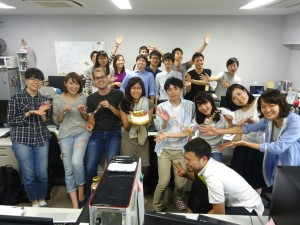
Head cocked to one side, I stared at my floormate with a puzzled expression as I tried to figure out her hand movements. It was nine o’clock on a Sunday night and I had sought her out to explain what my cleaning duties were for the next week while her dinner bubbled away on the stove. In many dorms at Osaka University, the students cleaned the common spaces, such as the kitchens and bathrooms. Since my suite is comprised of ten people, there is a weekly schedule splitting the tasks up so that only two or three people have responsibilities in a given week. With the Japanese textbook and dictionary in hand, I was able to translate my week’s duty as “general cleaning”. Based off of what was assigned to other people, I knew it didn’t include cleaning the fridge or the bathroom. Nevertheless, as a new resident, I didn’t know what type of cleaning “general” encompassed.
This confusion is what brought us to be sitting on the kitchen floor as we played a form of charades. Since many of my floormates don’t speak English, I often have to rely on strings of vocabulary words learned during pre-orientation and self-study, as well as many gestures. As she traced out objects in the air, I tried to visualize what she was saying as she punctuated her motions with spurts of rapid-fire Japanese. Nonetheless, I got lost at many points of the conversation. She must have noticed the confused look on my face after a while. At that point, she took my hand, led me to the bottle of alcohol wipes on the kitchen table, and started to clean the table with confident broad swipes. As I continued to stare at her in confusion, she grabbed a cloth hanging off a hook near the microwave and started to run it vigorously along the floor between the entryway to the end of the hallway, and back. It was at that moment that I caught on to what she was doing and chased after her to finish the cleaning myself. When I got to her, however, she held the cloth away and just gave me a toothy smile in reply. Seemingly forgetting that she had left a pot on the stove (which thankfully did not burn), she proceeded to clean all the spots that were part of my cleaning duty for the week. Every time I indicated I wanted to help, she would just shake her head and hold the cleaning supplies away from me. I was only allowed to help several minutes later, when she threw the used alcohol wipes into the trash and motioned towards the bags of waste waiting at the door. Several trips down the five stories of my dormitory and the neighboring hill to the disposal area later, the cleaning was done, and though a bit saggy at the tips, her dumplings were as well. As we stepped out of our shoes at the entryway to the suite, she turned to me, her eyes twinkling, and asked “wakarimashita?”. I nodded profusely and responded with “Hai” and many “domoarigatogozaimashita”s.
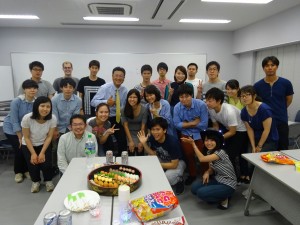
While in Japan, I have found that many people are willing to go out of their way to help you if they can see you are confused after an explanation. Whether it’s a storeowner leaving their shop unattended for a few minutes to show you the route to a famous shrine, or this scenario, they are very open to assisting people in any way that they can. In this instance, while I tried multiple times to help my floormate with the cleaning, her repeated refusals reflected her desire to make me feel at ease in this new housing arrangement. While it is a bit uncomfortable at times to be the recipient of such aid, I have found that it often is the best to just accept their courtesy. Of course, it is important to show gratitude for their help, but after talking with labmates and Japanese friends, it may even even be impolite to refuse their offer. Though I will strive to be fairly self-sufficient over the next few weeks, I know situations like these will invariably happen; I hope I will be able to act in the best manner.
Question of the Week
Osaka is the middle of tsuyu, a rainy season that occurs from June to mid-July. Have there been any initiatives aimed at harnessing the energy of the significantly increased rainfall, such as from a hydroelectric standpoint?
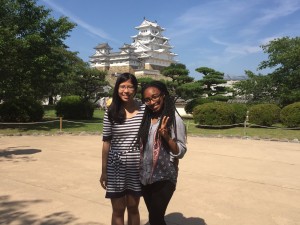
Research Project Update
I completed the first run of assays evaluating the direct cytotoxicity of porphyrus envelope. The results were positive, but I will have to conduct further runs of the assays to validate them and to test for statistical significance. I also spent this week getting more comfortable with the experiment protocols I will be using this summer, such as porphyrus envelope preparation.
The primary setback in my research is the rate at which prostate cancer cells grow. As with many projects involving cells, it is necessary to allocate significant periods of time between experiments or grow several batches of cells at once; a flask of cells may take between 2-5 days to reach appropriate confluency depending on the cell type. This growth rate has limited me to one run a week thus far. Next week, I will be performing the next trial of experiments using the cells cultured over the past few days.
Return to Top
Week 06: Preparation for Mid-Program Meeting
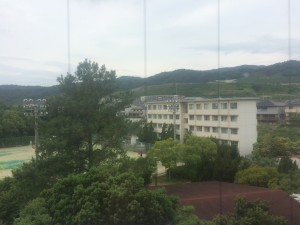
We sat together hunched atop of her mattress, peering at the page that lay between us. The room’s silence was quickly broken by the sound of a pen touching the sheet and the words “This phrase is grammatically incorrect—I think this would work better…”. I was helping one of my floormates correct her practice essays for the IELTS, the British form of the TOEFL. The exam measures English speaking, writing, listening, and reading abilities. As it is a common prerequisite for study abroad in an English-speaking country, many Japanese college students take it during this time of year so that they can start planning for next semester. My floormate was taking the exam in a few weeks and, though she was comfortable with the speaking portion of the exam, she was still feeling uneasy about the writing portion. This section, which consists of a graph analysis as well as an opinion piece, was extremely time-crunched. She was worried that in her haste to finish both parts in the time limit she would make grammar errors or use improper word choices that would hurt her final score.
This concern is what led us to that moment, with me reading her essay and pointing out any errors or points that could be improved, and her scribbling down notes at the page’s margins. Noticing recurring issues in her writing, I gave her ideas on how to address them and form a stronger essay. A lab mate has also been preparing for the same exam; between reading both of their textbooks and study materials, I feel like I have at least a decent understanding of how to help them reach a higher score on this section of the exam. Each time she reaches a deeper understanding of a grammatical topic feels like a small victory for me as well. As one of my favorite pastimes is writing, this experience was definitely one of the most fulfilling ones I have had while in Japan. I cannot describe the joy I felt when she said on the night before her exam that she was feeling much better about the writing portion and finally ready.
While language has been the basis of a significant personal accomplishment while in Japan, it has also played a role in the largest challenge. Having had learned all the Japanese I know since arriving five weeks ago, my skills are still extremely limited. When those around me are speaking in Japanese, I can understand a small handful of words and on a rare occasion can follow the topic of conversation. For the most part, however, I often feel like an untethered boat floating around a sea of words I do not understand. This scenario has made it so that many of the conversations I have lean towards being in English. On one hand, I very much appreciate the other party’s effort to make me comfortable (often at the expense of their own comfort). Nevertheless, I have also felt that my Japanese skills have declined significantly since orientation. While I do review my notes from language classes, I know that I will really only learn the material through repeated practice. Therefore, I try my best to only use Japanese when interacting with people I meet while traveling on weekends. However, I am cognizant that with my level of Japanese, the types of conversations I can have are severely limited. The vocabulary words I know do not always translate to complete sentences. Therefore, while it may be an inconvenience for Japanese people to speak to me in English, it might be a greater one for them to parse through what I’m saying.
On the lab side of things, experiments have been running pretty smoothly. I will perform the third run of direct cytotoxicity assays next week and then start on the next section of the project. While I am running a bit behind schedule in regards to the anticipated timeline, I believe I will be able to finish all planned experiments before the end of my eight weeks. The abnormally slow cell growth rate I encountered in the first week has been resolved. While it still takes a few days for the cells to reach appropriate numbers, the speed it much faster than before. This weekend, several members of my research subgroup presented at a photodynamic therapy conference in the Tokyo area, and once they return they will be teaching me the procedures for the other portions of my project.
Question of the Week
In light of recent world news, how do the Japanese people feel about Brexit and the effect it has had on the value of the yen?
- If you’re interested in getting the latest news/reactions to world events like Brexit while you are in Japan its helpful to look through the websites of some of the English language newspapers in Japan for the topic you are interested in. This is a good way to not only stay connected to global events when you are abroad but really get a sense for what your host country’s reaction or thoughts are on this topic.
Research Project Update
This week, I conducted the second run of assays evaluating the direct cytotoxicity of porphyrus envelope under the guidance of Inai-san and Saito-san. I attempted to take the absorption spectrum of my solutions using what was leftover from the cell toxicity experiments. However, they contained D-MEM as the background solution, and the spectrometer was unable to make any readings. I will attempt this experiment next week again using PBS (which is normally used as background). I will also perform another iteration of the direct cytotoxicity experiment.
Return to Top
Week 07: Overview of Mid-Program Meeting & Research Host Lab Visit
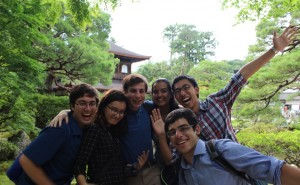
From beneath the heavy blanket of humidity and heat covering Kyoto rose Ginkakuji. Though less flashy than Kinkakuji (“Temple of the Golden Pavilion”), the “Temple of the Silver Pavilion” hearkens back to Japan’s olden times. Winding past the Kannon Hall, through immaculate Zen gardens, was a relaxing experience after a day of presentations and lab tours at Kyoto University. Earlier that day, the Nakatani RIES fellows had presented a brief overview of their work so far to a mixed audience of graduate students and professors from Osaka and Kyoto University, as well as to people affiliated to the Nakatani RIES program or the Nakatani Foundation. Following the presentations and lunch with Kyoto University members, we learned about the interdisciplinary work being conducted at Kyoto University’s iCEMS, the Institute for Integrated Cell-Material Science. The following visit to Ginkakuji gave us the chance to contrast the new and old Kyoto—the complex machinery in Kyoto University labs vs. the centuries-old temples.
The mid-program meeting and preceding lab visit were overall wonderful ways to catch up with other fellows and the program staff. The lab visit in particular was an opportunity for me to reflect upon my time at the laboratory so far. Practicing my mid-program presentation with the program staff, an audience unfamiliar with my work, was very helpful. Being able to adapt the way I present and answer questions to be understandable to non-biologists was the biggest challenge I faced during the mid-program presentation, the pointers they provided were very insightful. The lab visit also gave me the chance to get to know the other Osaka University laboratories hosting Nakatani RIES students through the izakaya/bowling outing. Meanwhile, the mid-program meeting was a great way to reconnect with the other Nakatani fellows and Nakatani Foundation program staff. Though the LINE chat was kept alive during the month we were all apart, it was wonderful to see the other Nakatani RIES fellows in person and to hear stories from their own mouths. The de-briefing session gave me a lot more context of others’ experience at their laboratory. I also greatly enjoyed seeing Packard-san as well as Nakatani Foundation’s Endo-san and Ogawa-san. It had been strange to go from having daily conversations with all these people for three straight weeks while we were in Tokyo to almost none in Osaka.
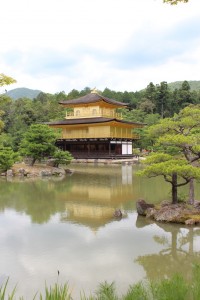
Though I had already visited several shrines and temples during my visit to Ise Shima and Nagoya earlier that weekend, as a shrine and temple enthusiast, I was very excited to visit the ones on our program itinerary the day following the presentations. As the cultural center of Japan, Kyoto is home to many World Heritage sites, two of which were on our itinerary on the sightseeing day of the meeting—Kamigamo Shrine and Kinkakuji. During our visit to Kamigamo Shrine, we were lucky to be able to be part of a purification ritual as well as enter the inner portion of the shrine where normally tourists can not enter. Since the sun was fortunately out that day, Kinkakuji was especially beautiful. At certain angles, it was almost blinding from the sun’s reflection off of the golden gilding of the temple, which had been used to purify negative thoughts and feelings towards death. The temple’s reflection in the adjacent pond was also quite lovely. In between visits to these temples, we had the opportunity to participate in sado, a traditional Japanese tea ceremony. It provided insight into another integral part of Japanese culture as a ritual dating back centuries that revolved around one of Japan’s most popular drinks. The perfect cap to the day was dressing in yukata and play with hanabi, fire art. The smoke rising in the air did little to hide our bright smiles as we twirled sparklers against a backdrop of a quickly darkening sky. The following morning, we drove over to nearby Kobe to visit Technopark, the research and development core of Sysmex. The Nakatani Foundation, which is funding this fellowship, was established by the founder of the current Sysmex Corporation, Taro Nakatani. As I am passionate about the biomedical field, it was very interesting to visit the core of machines I have seen while in hospitals and laboratories.
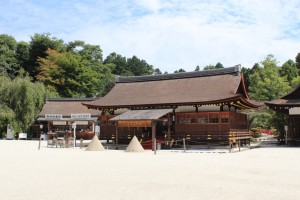
The mid-program meeting was an amazing way to dig deeper into Japan’s culture and reflect on my experiences so far in preparation for the program’s final month. It made me realize how much I had valued the presence of the other fellows and the whole Nakatani RIES team during my time in Tokyo. As a rough marker for the 2/3 point of the program, it was a reminder of how quickly my time in Japan was coming to a close. It was a wake-up call that I should be enjoying the little time I have left to the fullest.
Question of the Week
Many shrines in Kyoto do not charge admission fees. How do they pay for the myriad of expenses linked to their upkeep?
- Much of the funding for temple and shrine upkeep comes from the donations of coins and other support given by those coming to worship. However, in Kyoto many of the most popular shrines are free even though many temples do charge an admission fee. Some have called to increase admission fees in light of the increase in foreign tourism but this is controversial as this would increase the cost for local Japanese too. However, as the numbers of Japanese who regularly visit and donate to shrines and temples is decreasing many are having to make hard choices about how to increase revenue or even close due to lack of sufficient financial support.
Research Project Update
This week, I conducted the third and final run of assays evaluating the direct cytotoxicity of porphyrus envelope under the guidance of Inai-san and Saito-san. After returning from the mid program meeting, I will evaluate the fluorescence spectrum of porphyrus envelope. The following weeks will consist of investigating the kinetics of photosensitizer accumulation in normal vs. tumor cells as well as looking at the cytotoxicity of porphyrus envelope in photodynamic therapy.
Week 08: Research in Japan vs. Research in the U.S.
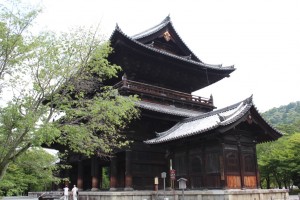
There was a brief pause after the final slide disappeared as everyone processed the presentation. “Are there any questions?” inquired the moderator for that week’s lab meeting. A professor spoke up. “This concept seems interesting, how about you use this technique…” Participating in laboratory meetings here in Japan has been a very valuable experience as they have allowed me to gain a deeper understanding of my research field and the laboratory’s other endeavors. While they are quite similar to the ones I have taken part in in the United States, there are a few distinctions which encapsulate what I believe are the main differences between laboratories in the United States and those in Japan.
One of these differences is the tone of laboratory meetings. While it is very common to have the principal investigators of a U.S. laboratory stop a presentation midway to ask a question or clarification, it happens rarely in the Awazu laboratory. Additionally, there are a lot more discussions between presenters and questioners in U.S. laboratories as opposed to those in the Japan. It is often very acceptable in the U.S. to voice any disagreements with the methods of investigation or interpretation of the results, even when voiced in opposition to someone with a higher position in the laboratory. In Japan, on the other hand, such conversations do not take place. Many Japanese students readily accept professor’s comments and completely follow their suggestions.
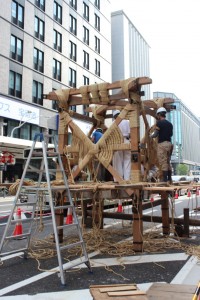
This tendency is tied to the fact that laboratories in Japan have a much stricter hierarchical structure than those in United States, as we had discussed in pre-orientation. The professor is at the top of the pyramid, assistant/associate professors in the tier below, then each year of graduate students fills each level under that with the B4 (fourth year undergraduate students) at the very bottom. While stratification is not so rigid among the students themselves in terms of levels of respect, there is quite a bit of gap between the professors and the students. Nevertheless, I have found that the professors are still very accessible—in the Awazu laboratory, one assistant professor’s desk is even in the same room as all the students. Meanwhile, the B4, masters, and doctoral students readily interact with each other, with several going out to lunch/dinner together on a daily basis. There is also a strong mentorship environment. For instance, on Fridays, every member of the laboratory must send a weekly report of their work to every other member of the laboratory. On Thursday nights/Friday mornings, it is very common to see the older students reviewing the reports of the younger students before they are sent off to be reviewed by the laboratories’ professors. During lab meetings, students must also present chapters from a laser engineering textbook. The older students help the younger ones with these presentations. In return, the younger students are often in charge of cleaning the office and shared spaces. I have also noticed the way the students address each other often depends more on their familiarity with the person as opposed to their age, with some even referring to each other using nicknames. However, the professors are always referred to using sensei.
Nevertheless, there are still several similarities between U.S. and Japan laboratories. In both, every member of the laboratory is expected to make contributions during the laboratory meetings, even it if it is just asking for a clarification of a concept. For the first month in the laboratory, Awazu-sensei would cold-call me after presentations, which made me used to such an environment. In terms of academic research, results are the most valued in both the U.S. and Japan due to the smaller pool of research grants/funding available in both areas.
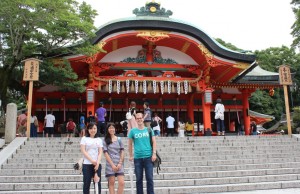
Though the pre-orientation gave me an idea of what to expect in a Japanese laboratory, the quirks tied to joining a new laboratory kept me on the balls of my feet the first few weeks in Osaka. While my experience has definitely been quite different from my previous laboratory in the United States due to differences such as lab size (Japan: 34; United States: 5) and culture, I have really enjoyed me time so far in the Awazu laboratory. It is difficult for me to say right now which environment – the U.S.’s or Japan’s – I prefer, but perhaps in the second half of my time here it will become clear.
Question of the Week
Japanese bookstores devote significant amount of space for manga, Japanese comics. Meanwhile, American bookstores generally dedicate much less space for comic books. What caused comics to become so much more popular in Japan as opposed to in the U.S.?
- Manga: Heart of Japan Pop Culture (Japan Times, May 26, 2009)
- JapanGuide.com – Manga & Anime
- Manga is Still Hugely Popular, So Why Don’t We Talk About it More? (Comics Alliance, Sept. 23, 2015)
Research Project Update
As the cytotoxicity assays I have been performing take three days to run, and the Mid-Program Meeting meant that I arrived back to the laboratory on Thursday, I was unable to run an assay this week. Nevertheless, I prepared to add an irradiation component to the cytotoxicity assays I have been performing as I will begin such experiments in the coming weeks.
Return to Top
Week 09: Reflections on Japanese Language Learning
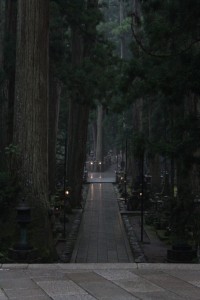
A stream of particles and vocabulary words rushed through my head as I stood before twenty sets of still-unfamiliar eyes. I was trying to improvise a section of my self-introduction to the Awazu laboratory, but I felt it rapidly deteriorating. In sharp contrast to the sharp, clipping pace of the memorized section of the introduction, this part was littered with short pauses as I struggled to come up with the correct word and conjugation. Though I was able to stitch together (hopefully) understandable phrases, communication has definitely been one of the biggest challenges I have faced this summer.
One such linguistic struggle occurred when I visited Koya-san. Koya-san is the center of the Shingon Buddishm sect, with several temples around the Garan temple complex that Kobo Daishi, an important Japanese religious figure, established on the mountain when introducing Shingon Buddhism to Japan. When visiting Okunoin, the site of Kobo Daishi’s mausoleum and home to a haunting hall of lanterns, I got a bit carried away and only realized how much time I had spent there when the sky began to darken. When I made my way back to the bus station, I discovered all the restaurants and eateries that were open when I wandered into the temple were shuttered. The once bustling bus station was also devoid of anyone else. To my dismay, my stomach soon announced that it was ready for food. Pretty soon after, a tourist couple stumbled into the station and I asked them if they knew where to get food on the mountain. They answered that restaurants in the town center closed at 6 pm, which is why they had opted to reserve food at their temple lodging. The best place to find food was on the outskirts, where some of the locals might have their own eateries not frequently populated by the hordes of tourists that descended in the areas during the daytime. I thanked them for the information and set out to find someplace to eat. By then, a few streetlamps and the stone lanterns lining the walkway to the cemetery nearby were the only light sources remaining. Nevertheless, I walked along the main highway in search for food. After a few minutes, I happened open an elderly man unlocking his gate. I approached him with a sumimasen (excuse me) and asked if there were any restaurants nearby. He shook his head no and my face crumbled. He must have noticed because he started speaking in rapid-fire Japanese. As my face morphed into one of confusion, he started to slow down, and I began to pick out some words here and there, such as “food” and “water”. “Where is it?” I asked. He responded with what seemed like an address. I picked a direction and pointed. “There?” I inquired. “No,” he replied. “It’s to the right from here.” We went back and forth as I built a mental map of how to get to the café I would stumble upon several minutes later.
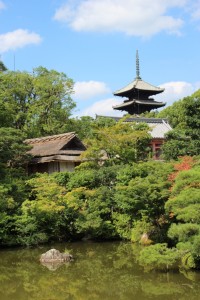
Though I have struggled with the language on several occasions, there have also been many times when I have been able to see how much my Japanese language skills have progressed. One such instance was when I was able to hold a conversation with a Japanese housewife as we walked the same way to a nearby bus stop about our daily lives and why I was in that neighborhood of Kyoto. While I have not been using a lot of Japanese while inside the laboratory, I try to listen to any Japanese conversation to try to pick up a few new words. This tactic has been really helpful for learning casual speech as much of what we learned in Tokyo during language classes was formal speech. On the other hand, while traveling on weekends or national holidays (ie. July 18th was Sea Day), I try my best to communicate solely in Japanese. The language has really fascinated me so far, and I will definitely continue my studies upon my return to the United States.
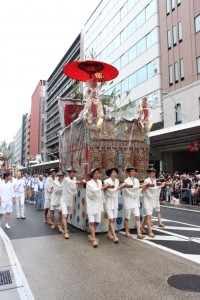
Question of the Week
What are the origins of the cultural differences between people in Tokyo and Osaka?
- This could be something interesting to ask your lab mates about, what do they think about the differences between Tokyo and Osaka but here are a few articles on this topic that might be interesting to review too.
Research Project Update
This week, I cultured more prostate cancer cells and continued my preparation for the cytotoxicity assays with irradiation which I will begin conducting next week.
Return to Top
Week 10: Interview with Japanese Researcher
I had the pleasure to interview Homare Hashiya on the career path of a Japanese researcher this week.
What is your degree?
I am currently an M2 student in the Awazu laboratory (Division of Sustainable Energy and Environmental Engineering, Graduate School of Engineering, Osaka University). I received my bachelor’s degree from the same department.
Why did you decide to study in this field?
When I was an undergraduate, I was majoring in physics but realized I was more interested in physics applications. I chose the Awazu laboratory because I wanted to study applications of physics in the medical science field and thought my background from undergraduate studies would be helpful.
What is it like to be a student in the Japan?
We can leave anytime from the laboratory if you finish your work. Any time we are not doing work, we can use freely. However, this freedom depends on the laboratory; in other laboratories, students must stay for set amounts of times. We have weekly reports, monthly, yearly, as well as graduation reports. We also take classes taught by professors in the department. We have two types of classes—environment and energy. In environment classes, we learn about water and architecture. In the energy class we learn about nuclear reactors/reactions. These classes don’t relate to my research, but they are interesting. I think American graduate schools are more difficult than those here in Japan.
What is your career path?
Though many people usually follow paths related to your research, I want to explore the business side of engineering in the future.
What is the nature of your work environment? How do you think that a lab in Japan differs from the US?
I enjoy my work environment because we can do we want to do and teachers are very supportive. We spend a lot of time together, including yearly trips overseas (ie. Shanghai and the upcoming Taipei trip). I am not sure what laboratories are like in the U.S., so it is a bit difficult to talk about the differences between work environments.
What is your international experience?
I have been to an academic conference of the American Society of Mass Spectrometry in San Antonio, Texas. I also went to Malaysia for an internship. It was a 2-week engineering internship on agriculture.
How many international researchers work in your lab? How has the internationalization of research impacted your work?
There are two right now, you (Erica) and Julian (a visiting master’s student from Germany). I like having international researchers because we can talk about research and other cultures. It is very interesting because they have different ideas and I can learn various things.
What are they interested to know about the US?
I am interested in learning more about laboratories in the United States!
Question of the Week
Is studying abroad popular in Japan? Do many undergraduates go abroad given that Japanese universities have substantially different school years than other countries?
- Students who want to study abroad in Japan face a number of challenges. First, the academic calendar in Japan is not in sync with the academic calendars in the U.S. or Europe which means students can only participate in very short-term experiences over the spring or summer break period or that students must often commit to studying abroad for an entire academic year. Another challenge is that to study abroad Japanese students must typically make a minimum score on a test of English (TOEFL, IELTS, or TOEIC) since they will typically have to take all of their coursework in English when abroad. In comparison, there are many study abroad programs in countries worldwide that are open to U.S. students who have no prior language experience. Funding is another significant barrier to study abroad as university education is a heavy financial burden for most Japanese families already. The Japanese government has initiated a number of programs and scholarship scheme to help encourage more Japanese students to study abroad and there are reports of initial positive results based on 2012 survey data. According to the Institute of International Education’s Project Atlas report the top 5 destination countries for Japanese students are the U.S., Canada, the United Kingdom, and South Korea. Japanese universities and Japan’s government seek to continue to increase the numbers of Japanese students studying overseas. This often begins with greater access to English language coursework, particularly speaking and listening in English, and a Ministry of Education panel just unveiled a plan to make English an official course for students in Japan from grade 5 on-wards to “better prepare students for an international environment”.
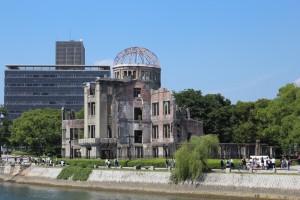
Research Project Update
This week, I learned how to use the laser irradiation set-up for photodynamic therapy experiments. I also performed the first run of an assay investigating the direct cytotoxic effect of porphyrus envelopes using light stimulation/PDT. I am very fortunate that this assay worked well as there are only two weeks left to complete all experimentation.
Week 11: Critical Incident Analysis – In the Lab
As I leaned over the table with money still in my outstretched hand, I felt a deep sense of embarrassment. Other laboratory members were reaching over to place their share of the bill on top of the check, but every time I attempted to do so, my hand was moved away by gentle nudges from those around me. Some people were already swinging their bags over the shoulders and walking to the door, laughing at another joke. Pretty soon, the bill was back in the waitress’s hand and, cheeks burning a bit, I returned the now-crumpled sen yen bills to my wallet. When I walked out of the izakaya, my stomach not only contained all of the mecha-oishii (Osaka slang for “very delicious”) food I had just consumed, but also a little ball of uneasiness from what just happened.
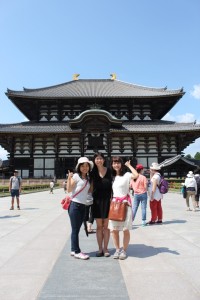
Members of my laboratory go out to a restaurant/izakaya near the office building or in Osaka every few weeks. When I am with only students, I am allowed to pay my share. I really appreciate when this happens because it’s an indication that they have accepted me as one of their own and not a guest. As soon as a professor comes, however, any of my attempts to contribute to the bill are denied, albeit in the typical politeness of the Japanese. During pre-orientation in Houston and orientation in Tokyo, we had discussed the practice of professors paying for a new student’s meal. Though when in the U.S., I usually “go Dutch” and split the cost of the meal (even when going out with a professor or advisor), after such briefings, I was fully prepared to have my attempts to pay my share politely declined during my first few weeks at the laboratory. However, such treatment continued throughout my stay in the laboratory, even weeks after the mid-program meeting.
While I was very grateful that they were willing to pay for my meal, my uneasiness is tied to the fact that when a sensei joins us for a meal, we often go to a more expensive place that I normally would not go to on my own. Since drinking is often involved in such affairs, the tab quickly rises to a sizable amount. Though paying for my share at these meals would stretch my stipend budget a bit, I would have been more than willing to do so. While the sensei usually foots the significant chunk of the bill, I have noticed some of the older students end up pitching in a bit more money if they withhold the bill from me, which makes me feel even worse about the situation. These people are willing to take the time to teach me new laboratory techniques and discuss any issues with my project during the day, and even after laboratory hours, they still take care of me. Every time I express my concerns and request to contribute my part to my bill, they brush them away just say “It’s ok, it’s ok. You’re the youngest. Let the older ones treat you.” Even if I respond that I want to pay, and that I don’t feel like it’s an obligation, they often laugh it off and just shift the check to the other side of the table. If these events were a one-off thing, I probably would not have felt that bad about it, but since it has already happened a couple of times since my arrival in Osaka, I still feel a tinge of unease whenever it happens. Such occurrences will probably not occur in the little time I have left in the laboratory, (I really can’t believe I only have one more week left with the Awazu laboratory!) but definitely stay on my mind for a few days after each time.
Question of the Week: What are some American customs that many Americans don’t believe to be impolite at all, but Japanese people find to be especially rude?
That would be an excellent question to talk with some of the Japanese Fellows about and you may want to read some of their student profiles to gain some insight on this. One thing that Americans tend to do is to ‘fill the silence’ in a conversation or talk over someone. This can be considered rude in a Japanese context where people naturally have more pauses or silent moments in the conversation. From an American perspective, we are trying to help the other person ‘find the right word/thought’ or move the conversation forward in an efficient manner but from the Japanese perspective this often makes them feel self-conscious and uncomfortable and may make it less likely for them to be willing to engage in a conversation. This is true of other international students in the U.S. too and this insight may help you be a better friend/mentor to the international students studying or working in the research lab with you.
- 11 American Behaviors that Are Considered Rude Around the World
- 15 Things American Do that are Considred Rude Abroad
- An Ocean Apart: What do Japanese college students think about the U.S.?
- What do the Japanese think of the US?
Research Project Update
This week, I performed further trials of WST assays to evaluate the direct cytotoxicity effect of porphyrus envelope with the addition of light stimulation/PDT. I also conducted a PpIX accumulation assay to investigate how quickly the photosensitizer concentrates in the prostate cancer cells and if such rates are affected by the use of HVJ-E or porphyrus envelope. Since my time in the laboratory is quickly coming to an end, I had to run four experiments this week (2 PDT cytotoxicity assays and 2 accumulation assays) as opposed to my usual 1 experiment/week; this schedule meant that I was often running experiments simultaneously and extending my hours. While the accumulation assays ran smoothly, unfortunately, for one of the cytotoxicity assays, the laser did not produce a high enough power density to induce a PDT effect. I will be repeating the assay early next week so that I can include it in the final poster.
Procedure: PpIX accumulation assay
PC-3 cells were seeded (5.0 x 103 cells/well) into a 96-well cell culture plate. Following 24 hours of incubation, cells were submerged in D-MEM (control), PpIX (4.75 pmol/HAU, 9.5 pmol/HAU), or porphyrus envelope (4.75 pmol/HAU, 9.5 pmol/HAU). After 10 minutes of exposure, the wells were washed with 100 μL of PBS/per well followed by a 10-minute incubation with 0.1% SDS solution. 80 μL was removed from each well and fluorescence was measured using the Spectramax Microplate Reader.
Results: Porphyrus Envelope shows higher levels of PpIX accumulation in tumor cells
The accumulation assay (sample size: 6) indicated increased direct accumulation of PpIX by the porphyrus envelope solutions in both the 4.75 pmol and 9.5 pmol concentrations as PpIX lipid alone. Porphyrus envelope showed a 42.9% and 116% increase in PpIX accumulation as compared to their respective PpIX lipid solutions for the 4.75 pmol porphyrus envelope solution and 9.5 pmol porphyrus envelope solution respectively. PpIX lipid in the 9.5 pmol concentration displayed a 116% increase in fluorescence compared to the 4.75 pmol concentration. Meanwhile, porphyrus envelope in the 9.5 pmol concentration displayed a 226% increase in fluorescence compared to the 4.75 pmol concentration. When compared to the control, HVJ-E did not display any fluorescence level.
Return to Top
Week 12: Final Week at Research Lab
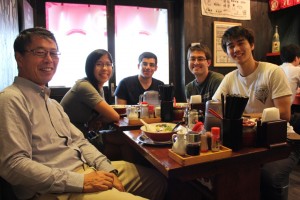
As my last day in the laboratory approached, I could hardly believe that almost nine weeks had flown by since I joined the Awazu laboratory. While the increased amount of assays I had to conduct and the imminent poster presentation meant that I was in the experiment room more often and spent overall less time with my labmates, my upcoming departure made me cherish each moment I had left with them even more. While I am looking forward to going home and seeing my family, I can’t help but feel quite sad that I will be saying good-bye to all the wonderful people I have met in Japan so soon.
When coming to Japan, I was very excited to see what was in store, but also a bit nervous. I had the opportunity to visit Japan for the first time in January 2016 through the Kakehashi Project, an international leadership development program focusing on cultural exchange. However, as it was a short experience (a total of 7 days were spent in Japan), I did not have the chance to develop deep relationships with Japanese people. As this program is much longer, I hoped to have the opportunity to form such relationships and, while I knew I would not be able to fully integrate into Japanese society, at least find a semblance of a place for myself here (of particular importance to me as half-Japanese). My anxiety quickly melted away when I was able to form bonds with my lab members.
I was honestly really surprised how accepting my laboratory was in particular and how quickly I felt at home in an environment that was markedly different from what I have experienced in the U.S. My image of working in a Japanese laboratory was of members staying for hours on end working on projects and never being able to sleep or talk to each other. What I found is that while they do work extremely hard, it doesn’t mean that they don’t take the time to grab drinks with each other at a nearby izakaya, grabbing a quick bite to eat during downtime, or helping each other out with projects or classes. Meanwhile, my time in Japan has also made me more aware of distinct aspects of American culture, for instance, the focus on individuality. While I do not necessarily think that the American or Japanese way of thinking is “better”, it has made me more cognizant of how I present myself and trying to find a happy medium between both methods.
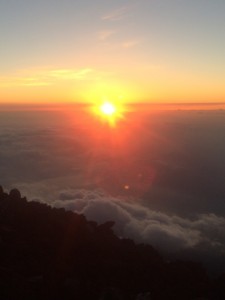
I have also noticed that I have changed quite a bit during my time in Japan. It has taught me to embrace the unknown—in a country where I could not speak the language and did not have a complete grasp on its culture, it was impossible to predict or control all the variables in a situation. There were several times when I was pushed way past my comfort zone, and they made me to become more adaptable and to thrive in unexpected situations. While I encountered some daily frustrations, mainly stemming from miscommunications because of language barriers, it made me become used to putting myself into another person’s shoes and see how their culture/upbringing may be affecting whether or not they’re understanding me. What I will miss most when I go back to the United States are the frequent situations in Japan that helped me grow as a person as well as the constant sense of “new” and adventure I felt every day. Nevertheless, this experience has definitely shaped what I envision for myself in the future. I am looking forward to pursuing more research in the coming summers during my undergraduate years as well as possibly a PhD in immunology or related field.
While I am sure further effects of my time in Japan will manifest themselves more clearly to me in the future, I have spent the past few days preparing to leave the Awazu laboratory. I am writing cards for all my laboratory members to hand out on my last day along with my good-bye omiyage for the students and separate ones for the senseis. The Awazu laboratory is also hosting a goodbye party for the German exchange student and I who are leaving on the same day. I am fortunate to have already finished up all my experimentation, and after killing off the leftover cells, am just analyzing results and creating my poster. While there are no current projects at Brown on photodynamic therapy, I am exploring other options in my home city of New York City. While I might be quite teary-eyed when I go, I know I will keep in close contact with my research group/host.
For my last weekend in Japan, I will be heading up Fuji-san with Sasha, Donald, Daniel, and Rony via the Fujinomiya trail. The tentative plan is to meet with the fellows that are hiking different trails at the summit to watch the sunrise together, but we will see what actually happens when we climb up the mountain. I am sure that it will be physically and mentally exhausting to make such a climb right after saying good-bye to our laboratories, but I can think of no better way to finish off our time in Japan.
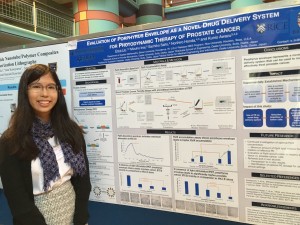
Final Research Project Update
Evaluation of Porphyrus Envelope as a Novel Drug Delivery System for Photodynamic Therapy of Prostate Cancer ![]()
Host Lab: Medical Beam Physics Laboratory
Host Professor: Kunio Awazu
Mentors: Norihiro Honda (Assistant Professor), Mizuho Inai, Sachiko Saito
Introduction: Prostate cancer is the second-leading cause of cancer-related death in men. Side effects from traditional therapies as well as increased treatment resistance have led to a search for more effective treatment modalities. Photodynamic therapy (PDT) has the potential to fulfill this need. PDT uses photosensitizers, light-sensitive drugs/dyes, which selectively accumulate in tumor cells. Light stimulation of the photosensitizers causes the formation of reactive oxygen species (i.e.: 1O2) only in tumor cells, sparing normal, healthy cells.
Approach: This study evaluated porphyrus envelope as a novel therapeutic agent for PDT. Porphyrus envelope is created by incorporating the protoporphyrin IX lipid (PpIX lipid), a photosensitizer, into the hemagglutinating virus of Japan envelope (HVJ-E). HVJ-E was used because it leads to immune cell recruitment and activation of anti-tumor immunity, and thus a higher therapeutic effect in deeper tissue. Additionally, HVJ-E’s fragmented RNA induces apoptosis in cells via the RIG-I pathway. Direct cytotoxicity assays as well as accumulation assays were used to evaluate the porphyrus envelope’s effectiveness.
Results: Direct cytotoxicity assays performed in this study found that HVJ-E alone and porphyrus envelope showed statistically similar decreases in cell survival rate in the absence of light stimulation/PDT. However, porphyrus envelope led to significantly lower tumor cell survival rate in the presence of light stimulation/PDT when compared to HVJ-E alone. The ideal irradiation wavelength (450 nm) was established using PpIX lipid’s absorption spectrum.
Discussion: Porphyrus envelope represents a novel drug delivery system that can be used to more effectively treat prostate cancer as well as enhance the treatment options of other types of cancers conducive to PDT treatment, including brain and skin cancers.
Future Research: Further research includes investigating the effectiveness of porphyrus envelope in an in vitro experimental system as well as evaluating drug accumulation in healthy prostate cells vs. prostate cancer.
Conclusion: While further research is necessary to determine several treatment variables, such as appropriate dosage and the optimal time between drug administration and light administration, porphyrus envelope shows promise as a novel drug delivery system for prostate cancer treatment.
Return to Top
Week 13: Final Report
When arriving in Houston, I couldn’t help but feel sad that my time in Japan was already over. Nevertheless, I looked forward to the Re-Entry programming, especially presenting my research in the SCI Symposium. The symposium was an excellent capstone to the experience and it was exciting to be able to share the work I had done this summer. I had to be flexible throughout the event, often modifying my explanations of various aspects of my project, which was very biology-heavy, to the judges, who were from chemistry, physics, or engineering backgrounds. I also enjoyed listening to the oral presentations and learning more about the interesting research being conducted at Rice University. It was overall a very educative experience and I learned so much about the work being conducted in fields I did not explore this summer as well as about the final results of the other Nakatani RIES fellows’ projects. What helped make the symposium such a great experience were the poster review and other informational lectures in the days prior. The feedback we gained during those talks definitely helped me feel more comfortable about presenting the research to a varied audience. It also allowed me to gain some insight on what parts of my project may not be very clear to someone who does not come from a biology/biomedical engineering background.
The Re-Entry program was also a great opportunity to get to know the Nakatani RIES Japanese Fellows better. As we only had limited time together in Tokyo, it was nice to finally have the chance to really talk with them. Exploring Houston together and explaining various parts of American culture in were particularly enjoyable. One example is when we went out for Tex-Mex food and I explained its origins and the differences between this type of cuisine and Mexican food. The trip to NASA with them was definitely a highlight of the Re-Entry Program. I have always held a passion for space/space exploration and it was exciting to have the chance to explore the facilities, such as the rocket park, with the Japanese fellows. It was also interesting to talk about NASA and its similarities/differences with JAXA, the Japanese equivalent of NASA, with them. Takuya, one of the Japanese fellows, is majoring in atmospheric science, and it was interesting to discuss the impacts of space exploration on our atmosphere.
Those few days also gave me some time to reflect upon my experience with the Nakatani RIES program and realize how much I have learned in the past three months. I know that when I go back home to New York City, and then to my sophomore year at Brown University, many of the conversations I will have — especially during the first few months — will revolve around Nakatani RIES. While what I talk about would differ depending on the audience, future conversations with professors may include discussions on the laboratory skills or the knowledge I gained in a variety of fields, from immunology to laser physics, during the program. During family conversations, I may refer to all the insights I gained on various aspects of Japanese culture, including its rich history, complex societal norms, and intriguing politics. I especially look forward to discussing such topics with my maternal grandparents, who while of Japanese descent, grew up in Brazil. I can already envision the bounty of conversations we will have as we delve into how Japanese culture manifests itself when mixed with different cultures, beliefs, and ways of living.
Meanwhile, I may refer back to my experience of working in a laboratory in a different country when speaking to an employer to highlight my adaptability and willingness to engage with varied ideas and people. I may also highlight the global understanding I gained while living abroad in Japan, which is increasingly important due to the rising number of multinational collaborations, especially in research. Partnerships between teams in different countries would not be possible without people who understand the cultural backgrounds between each party in order to facilitate links between them. I hope to have gained the cultural competence and flexibility through Nakatani RIES to act as such a bridge. Notwithstanding, these aspects do not encapsulate the many ways I grew as a person during the program—it may take time for those that are not as apparent to manifest.
Nevertheless, as much I wish I would have had more time at my host Japanese university, I am heading back to my American college shortly. To be quite honest, it has felt strange to be back in the United States and I have experienced a bit of culture shock. Nonetheless, I know that Nakatani RIES will definitely continue to shape my experiences moving forward even when I’m back at my home university. Due to this experience, I hope to return to Japan next summer to conduct more research. I will be applying for funding and to Japan-based research programs throughout the next year. I also hope to improve the language skills I gained this summer by going to language tables at my university. I’m also looking forward to speaking to prospective applicants at my university about this amazing experience and encouraging them to apply. I will think back to all the times I was feeling unsure or uncomfortable but still took the risk to step outside my comfort zone. While it may be a bit nerve-racking to study abroad for a significant amount of time while still a freshman or sophomore, I will discuss with them how the best way to develop as a person is to embrace every moment of discomfort and run with it, instead of sidestepping any possible issue.
While all the information I learned and the skills I gained are definitely important, I would also like to highlight that it is the people I met throughout Nakatani RIES who made it such an incredible experience. The orientation program in Tokyo wouldn’t have been such an engaging blend of learning and of exploring Japanese culture if it hadn’t been for the support of Packard-san, the AJALT teachers, the visiting lecturers, and the KIP students. The Awazu laboratory made my time in Osaka an intellectually stimulating and enjoyable experience. Meanwhile, the Nakatani RIES program staff and the Nakatani Foundation provided the backbone of the program—I am deeply thankful for their dedication to providing all the Nakatani RIES fellows with the best possible experience. To everyone I met throughout this unforgettable experience, また近いうちに会いたいです(I hope to see you again soon)!
Follow-on Project
I look forward to sharing information about the Nakatani RIES program with students at my home university and will work with Brown University’s Office of International Programming to plan an information session. I will also discuss with the Japanese Cultural Association and various science/engineering-centered clubs at Brown about sending out information in their newsletters and hosting a mini-information session during one of their general body meetings. Other ideas include posting information about this program on social media, for example, in the Facebook group for Kakehashi Project participants.
Return to Top
Tips for Future Participants
Pre Departure Tips
- Study hiragana/katakana!
- Carefully study the papers the host laboratory sends and look into other projects being conducted at the host laboratory.
- Pack omiyage for the first day in the host laboratory as well as parting gifts.
Orientation Program Tips
- The Japanese classes are intense, but studying a bit each night and doing the homework diligently help a lot
- Don’t be afraid to ask questions if confused during one of the Introduction to Science & Engineering seminar
- Ask the Japanese students for suggestions on where to go in Tokyo or the surrounding areas
Mid-Program Meeting Tips
- Make sure to practice the presentation
- Take the time to learn more about the city/town where the Mid-Program Meeting is taking place
- Enjoy every second with the other fellows and program staff
Working With your Research Lab Tips
- Approach every interaction with an open mind
- Don’t be afraid to ask your mentors or other labmates questions
- Always say “yes” to every opportunity that they invite you to—they will often lead to your favorite memories of the summer!
Living in your Research Host City
- Take advantage of the culinary extravaganza that is Osaka. While not particularly healthy, its soul food, ie. okonomiyaki, takoyaki, kushikatsu, etc. are mecha-oishii (very delicious)!
- Osaka has a unique dialect—Osaka-ben! It’s very interesting to learn and it is very easy to pick up some words from labmates.
- Check out local passes for JR, Kintetsu Railways, etc. as they can greatly decrease transportation costs
Language Study Tips
- Study hiragana/katakana beforehand!
- Seek out opportunities to continue language study after the orientation program in Tokyo at the host university
- Don’t be afraid to ask your labmates for feedback on your language abilities
What Gifts to Bring
- Memorabilia from home university or hometown (ie. mug, hat, etc.)
- American sweets, keeping in mind that in Japan sweets are generally not as sweet as those in the U.S.
- “America-only” or limited edition products that may not reach Japan
What to Eat
- Everything! If you’re uncertain, just ask a local
- What to Buy in Japan
- Food products that would last a plane ride back to the U.S.
What to Buy in Japan
- Calligraphy
- Stationary
What to Do in Japan
- Watch a kabuki play
- Attend a summer matsuri (festival)
- Climb Fuji-san
Places to Visit in Japan
